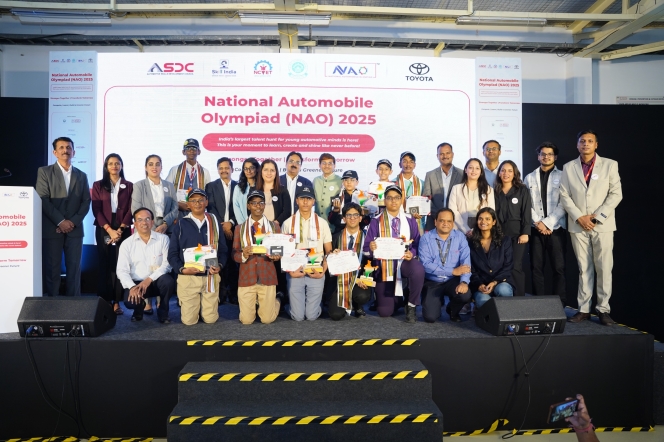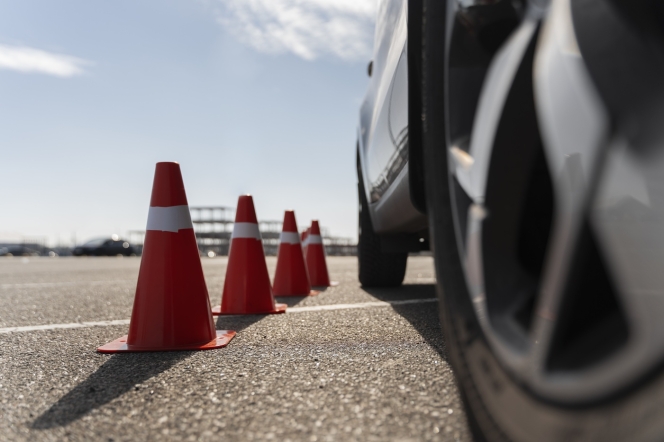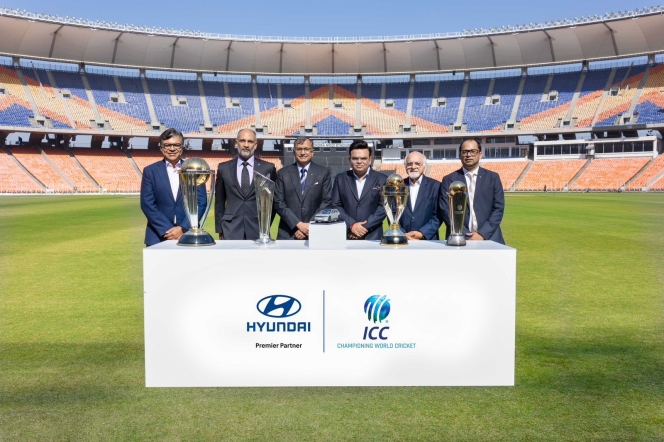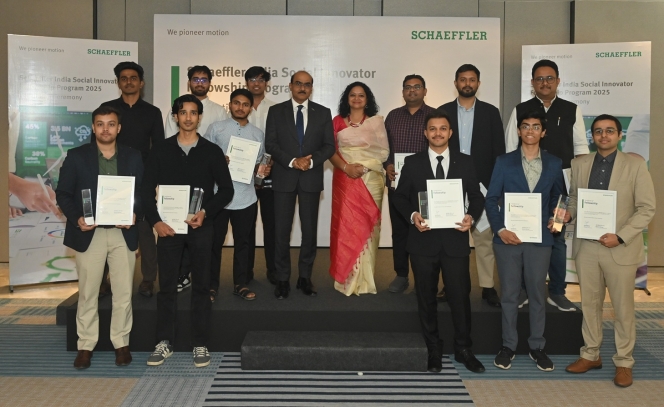- Renault Design Centre
- Renault Group
- Renault Nissan Technology & Business Centre India
- RNTBCI
- Renault India
- Laurens van den Acker
- Venkatram Mamillapalle
- Game Plan 2027
Renault Group Opens New Design Centre In India As Part Of Its Renault.Rethink Transformation Strategy
- By MT Bureau
- April 22, 2025
French auto major Renault Group has inaugurated its new Renault Design Centre in Chennai, as part of its new India-centric transformation strategy – renault. rethink.
The new design centre further strengthens the company’s ‘design in India’ and ‘make in India’ strategy. It is also expected to function as a hub of excellence, particularly due to its proximity to Renault Nissan Technology & Business Centre India (RNTBCI).
Laurens van den Acker, Chief Design Officer, Renault Group, said, "India is highly unique and locally driven. Having a dedicated design studio is essential to understanding its nuances, listening to its needs and building from its strengths. The Renault Design Centre Chennai will focus on developing models and concepts tailored to the Indian market while contributing to Renault Group’s global projects. By leveraging local talents and insights, this centre will play a key role in shaping Renault’s future mobility solutions. Its strategic location - at the heart of RNTBCI’s excellence hub - also enables closer collaboration across functions and faster integration of design into our engineering and innovation processes.”
Renault shared that the year 2025 marks an inflection point for the automaker in India, as it gears up to strengthen its presence in the world’s third-largest automobile market.
Venkatram Mamillapalle, Country CEO and Managing Director, Renault India Operations, said, "The launch of the 'renault. rethink' strategy heralds a new era for Renault in India. We are proud to be the most Indian of European carmakers, boasting the largest R&D centre, manufacturing unit, highly localised supply chain and now one of the largest design centres. The opening of new design centre in Chennai will play a crucial role in the deployment of the Renault International Game Plan 2027. Our commitment is to redefine our brand, product positioning, and customer experience to meet the evolving needs of our customers in the country, hence we recently witnessed the global debut of new ‘R store’ in Chennai, India."
It has renewed its commitment for India with a 90 percent localisation target, and the recent takeover of the alliance’s manufacturing plant RNAIPL.
In 2024, Renault Group clocked a record EUR 4.3 billion in profit, which is 7.6 percent of its revenue, and saw its revenue grow to EUR 56.2 billion, up 7.4 percent YoY.
Design & Engineering in India
At present, Renault Group’s Chennai R&D centre is one of its largest globally, with around 10,000 engineering working on global and local projects. Now, the Renault Design Centre Chennai extends over 1,500 metre and is equipped with the latest technologies. It features a high-tech environment designed for 3D model evaluation and virtual reality experiences, a next-generation visualisation studio, a creative collaboration zone, high-performance LED wall, advanced VR integration and a harmonious blend of European and Indian Design.
“renault. rethink is more than a sculpture – it’s a bold expression of Renault’s vision for India. It symbolises our commitment to innovation and to designing cars in India, for India. This artwork captures the energy of a nation in motion, a future taking shape, and Renault’s ambition to be part of this exciting journey,” stated Acker.
- Automotive Skills Development Council
- ASDC
- Central Board of Secondary Education
- CBSE
- Toyota Kirloskar Motor
- National Automobile Olympiad
- Dr Biswajeet Saha
- Vinkesh Gulati
- G Shankara
ASDC, Toyota Kirloskar Motor, CBSE Host National Automobile Olympiad 2025
- By MT Bureau
- December 24, 2025

The Automotive Skills Development Council (ASDC), in collaboration with the Central Board of Secondary Education (CBSE) and Toyota Kirloskar Motor (TKM), concluded the National Automobile Olympiad (NAO) 2025. The event took place from 17–19 December at Toyota’s manufacturing facility in Bidadi.
The initiative, aligned with the Skill India Mission, is designed to introduce school students to careers in the automotive and mobility sectors. The Olympiad saw participation from 175 students in Classes VI to XII. These participants were selected from an initial pool of over 136,000 students from schools across India and the UAE.
The three-day event included:
- Industry Masterclasses: Sessions led by experts on automotive fundamentals and emerging technologies.
- Technical Challenges: Competitions covering robotics, welding precision and technical problem-solving.
- Future Mobility Modules: Exposure to hybrid vehicles, data science and AR/VR tools.
- Industry Immersion: Visits to the Toyota manufacturing plant, the Toyota Technical Training Institute (TTTI) and test-track experiences.
The Olympiad concluded with the announcement of winners across three categories:
|
Category |
1st Place |
2nd Place |
3rd Place |
|
Grades 6–8 |
Abeer Verma (Bhopal) |
Aaradhy Pradhan (Ghaziabad) |
Dakhsh Kumawat (Indore) |
|
Grades 9–10 |
Anchit Sahai (Maharashtra) |
Arjun Annamalai (Chennai) |
Mahatva Jain (Jaipur) |
|
Grades 11–12 |
Nishanth Sudhakar (Chennai) |
Vidhan Herpalani (Dubai) |
Punith Kumar (Bengaluru) |
Dr Biswajeet Saha, Director, Training & Skill Education, CBSE, said, “We are delighted to see Toyota Kirloskar Motor hosting National Automobile Olympiad, which perfectly aligns with CBSE’s vision of experiential and skill-based learning. Events like this provide students with invaluable exposure to real-world automotive excellence and industry best practices. They also bridge the gap between classroom learning and practical application, inspiring young minds.”
Vinkesh Gulati, Chairperson, ASDC, said, “National Automobile Olympiad is a powerful platform to spark curiosity and channel young talent toward the automotive sector. ASDC is committed to building a future-ready workforce, and collaborations such as this with Toyota Kirloskar Motor provide students early exposure to real-world industry practices. The enthusiasm and technical aptitude displayed by participants reaffirm our belief in India’s next generation of mobility professionals.”
G Shankara, Executive Vice-President, Toyota Kirloskar Motor, stated, “We are proud to collaborate with ASDC in nurturing young minds through NAO 2025. By offering experiential learning and access to world-class skilling infrastructure, we aim to inspire students to innovate and contribute meaningfully to the future of mobility while supporting the Skill India vision.”
The programme concludes a cycle of assessments and training intended to bridge the gap between academic learning and industrial application in the automotive sector.
- SIAM
- Society of Indian Automobile Manufacturers
- National Road Accident Reduction Challenge 2026
- Safe Journey
- Prashant K Banerjee
- Devashish Handa
- Suzuki Motorcycle India
SIAM Launches National Road Accident Reduction Challenge 2026 For Students
- By MT Bureau
- December 23, 2025

The Society of Indian Automobile Manufacturers (SIAM) has launched the National Road Accident Reduction Challenge 2026 under its ‘Safe Journey’ initiative. The competition invites undergraduate students across India to develop solutions aimed at improving road safety and reducing fatalities.
The challenge targets undergraduate students in teams of two to four. Participants are required to submit field-tested or ready-to-implement ideas across several themes:
- User-centric interventions
- Technology-driven safety
- Infrastructure improvement
- Evaluation and enforcement
Submissions must include a 15–20 slide concept deck backed by data validation, fieldwork, or prototypes. The deadline for nominations is 15 January 2026, with final projects due by 1 March 2026.
Shortlisted teams will present their projects to a jury consisting of representatives from SIAM, vehicle manufacturers (OEMs), transport authorities and NGOs. The winning team will be awarded a cash prize of INR 250,000 at the SIAM SAFE Annual Convention 2026.
Prashant K Banerjee, Executive Director, SIAM, said, “In India, around 485 people lose their life daily due to road accidents. India’s young minds have the power to drive real change on our roads. The National Road Accident Reduction Challenge 2026 is designed to channel their creativity, problem-solving skills, and sense of responsibility into practical interventions that can be implemented on the ground. By engaging students as partners in road safety, SIAM aims to foster a culture of accountability, innovation, and safer mobility for the nation.”
Devashish Handa, Executive Officer, Suzuki Motorcycle India (SMIPL), said, “Road safety is a key focus area of Suzuki Motorcycle India’s CSR efforts. We believe that student-led innovation can contribute meaningfully to safer mobility in India. Through SIAM’s National Road Accident Reduction Challenge 2026, we aim to strengthen road safety ethics among the young generation and encourage practical, on-ground interventions to help bring down road fatalities.”
- Hyundai Motor Company
- ICC
- International Cricket Council
- Hyundai Motor India
- Jay Shah
- Tarun Garg
- Jose Munoz
Hyundai Motor Becomes ICC Premier Partner For 2026–2027 Tournaments
- By MT Bureau
- December 23, 2025

South Korean automotive major Hyundai Motor Company has announced a partnership with the International Cricket Council (ICC), serving as a Premier Partner for tournaments between 2026 and 2027. The agreement covers six major ICC events across multiple formats, including the Men’s Cricket World Cup 2027.
The partnership grants Hyundai exclusive rights for the international cricket calendar. These include participation in matchday moments such as the coin toss, in-stadium branding and fan experiences.
The collaboration aligns with Hyundai Motor’s sports strategy, which focuses on sports in specific regions. Cricket has an audience of over 2 billion fans, providing the brand with a platform to connect with audiences in markets such as India. This deal marks a return to the sport for Hyundai, which previously collaborated with the ICC from 2011 to 2015.
Hyundai subsidiaries will collaborate to offer vehicle showcases, interactive zones and digital engagement initiatives during matches. The partnership was announced at the Narendra Modi Stadium in Ahmedabad, India.
Jose Munoz, President and CEO, Hyundai Motor Company, said, "Cricket and Hyundai share a relentless drive to improve and the resilience to rise to every challenge. We are honoured to partner with the ICC and connect with over two billion passionate fans worldwide. In key markets like India, where cricket is a way of life, this partnership deepens our connection with the customers and communities who inspire everything we do. We look forward to creating memorable experiences together at these iconic tournaments."
Jay Shah, Chairman, ICC, said, "Cricket is among the world's most popular sports, with over two billion fans whose passion is especially evident during ICC's marquee events. These global events offer an excellent opportunity to engage fans through innovative digital and in-stadium integrations. We welcome Hyundai as a Premier Partner and look forward to delivering outstanding events together. Hyundai is a global brand that has long supported sports, and we look forward to maximising our combined strengths at these events."
Tarun Garg, Managing Director & CEO Designate, Hyundai Motor India, said, "This partnership reflects Hyundai's strong commitment to India and growing importance of India market in Hyundai's global operations. We look forward to some thrilling cricketing action and are ready with a 360-degree communication approach across PR, digital, experiential and dealerships to maximise this opportunity across the country."
Schaeffler India Announces Winners Of 4th Social Innovator Fellowship
- By MT Bureau
- December 22, 2025

Schaeffler India, a motion technology company, has named the winners of the 4th edition of its Social Innovator Fellowship Programme. The initiative identifies and supports individuals aged 18–35 developing solutions for environmental and societal challenges.
The programme focuses on several key areas, including environmental sustainability, renewable energy, carbon neutrality, the circular economy and natural resource management.
Following a screening process and prototype demonstrations, 10 projects were selected from 172 eligible applications. Each winner received a grant of INR 175,000.
The winners will also participate in a 24-week hybrid mentorship programme at IIMA Ventures, part of the Indian Institute of Management Ahmedabad. This phase provides tools, frameworks and expert mentoring to prepare the solutions for the market and assist in scaling their impact.
Since July 2025, the programme received more than 460 registrations from 21 states across India, including Maharashtra, Karnataka, Tamil Nadu and Delhi. Out of these, 103 applicants were shortlisted for final assessment.
Harsha Kadam, MD and CEO, Schaeffler India, said, “Change is the only constant. In a dynamic world where environment and technology play a fundamental role to meet the evolving needs of the world’s populus, the Social Innovator Fellowship Program speaks volumes of Schaeffler’s commitment to ESG and building not just a technologically advanced business model but be sensitive to the environment we operate in. It is our commitment to building a sustainable future that drives us to keep supporting this program year on year. With the response rates from participants growing over the years it’s overwhelming to see the indomitable spirit where technology and human consciousness collaborate to build a better world."
"We are happy that program is designed to identify and empower young changemakers who are developing scalable, impactful, and technology-driven solutions. In doing so, Schaeffler aims to harness entrepreneurial spirit and provide a platform where innovators can translate their ideas into transformative actions that make a sustainable impact on society,” added Kadam.
The award ceremony featured representatives from academia and the development sector, including Professor Gurudas Nulkar from the Gokhale Institute of Politics and Economics, Munish Bhatia of India Accelerator, Dr Bharat Kakade from the BAIF Development Research Foundation and Ankur Sohanpal of IIMA Ventures.






Comments (0)
ADD COMMENT